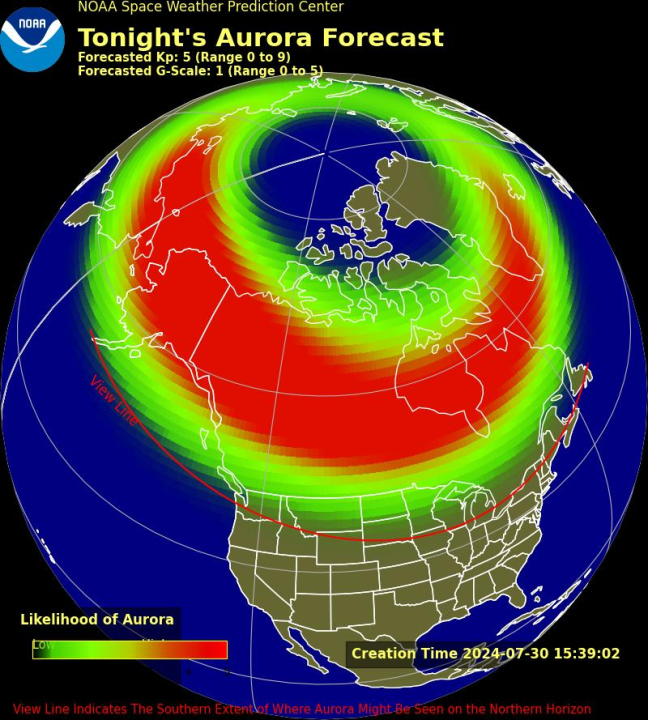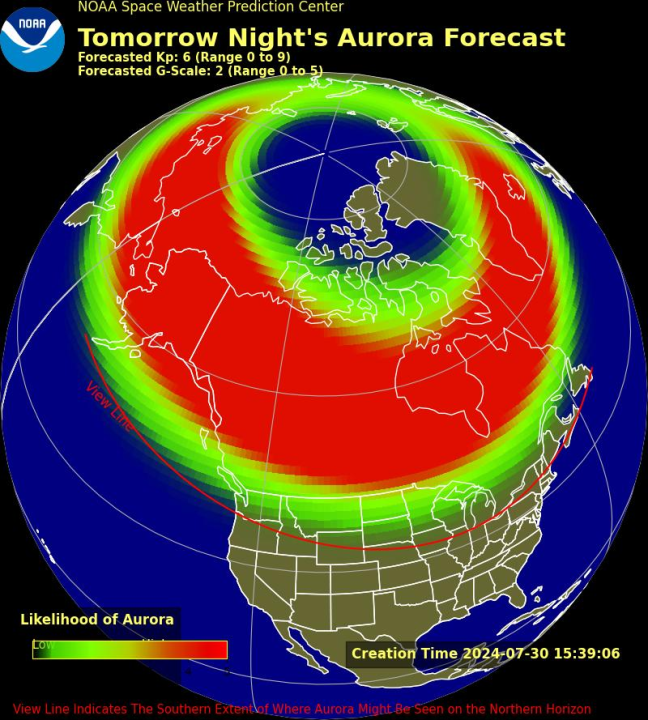Forecast: Northern lights expected in US this week as geomagnetic storm watch extended
(NEXSTAR) — Solar activity is picking up after an already active weekend, according to NOAA’s Space Weather Prediction Center (SWPC), prompting forecasters to extend the geomagnetic storm watch issued Monday through the week.
The sun recently sent out a massive solar flare reaching X1.5 strength — while not as strong as the X5 flare reported earlier this year, it was one of the strongest in 2024. Others, as well as filament eruptions, have also sparked coronal mass ejections (CMEs), according to the SWPC.
With some of those apparently en route to impact Earth, the SWPC issued a geomagnetic storm watch on Monday, noting conditions could reach G3 strength through Wednesday. Monday evening, the SWPC extended the geomagnetic storm watch through Thursday “due to a number of CMEs,” four (and potentially more) “have anticipated Earth-directed components.”
Tuesday is expected to see the strongest storms at G3, while G2 watches have been issued for Wednesday and Thursday.
While geomagnetic storms can impact our navigation, communication, and radio signals, officials say these systems are prepared for such influences. What you may notice, however, are the northern lights.
CMEs, like those forecasted to hit Earth this week, are essentially plasma and magnetic material hurled from the sun. As that material collides with Earth’s magnetic field, particles are shot toward the poles. When those particles interact with the gasses in our atmosphere, they create energy, which appears to us as bursts of light that we call the aurora.
The stronger the geomagnetic storm (the term used to describe the impacts of the aforementioned solar activity), the further south the northern lights can appear in the U.S. Geomagnetic storms are measured on a five-point scale, ranging from G1 to G5.
G1 storms are capable of bringing the aurora to much of Canada and Alaska, as well as the most northern expanses of the Lower 48. At G5 strength, the aurora could be visible as far south as Hawaii, Florida, and Texas.
With current forecasts suggesting geomagnetic storms will peak at G3 this week, it’s generally expected that the northern lights could reach as low as Illinois and Oregon — as long as the CMEs impact Earth at the right time.
“Should the forecast conditions occur during the late evening hours, the aurora could become visible at times as far south as the northeast U.S. through the upper Midwest, and across the rest of the northern states to include northern Oregon,” the SWPC said Monday.
As of Tuesday morning, the SWPC’s modeling, seen below, suggests the aurora will be visible in those regions. While Alaska and Canada, shrouded in red on the map, have the highest likelihood of seeing the northern lights, residents in more than a dozen states — Oregon, Idaho, Montana, Wyoming, North Dakota, South Dakota, Minnesota, Iowa, Wisconsin, Illinois, Michigan, New York, Vermont, New Hampshire, and Maine — could see the celestial show on their northern horizons.

The Geophysical Institute at the University of Alaska Fairbanks’ aurora forecast shows the northern lights could reach even further south on Tuesday, reaching into Nebraska, Indiana, Ohio, Pennsylvania, Connecticut, New Jersey, Rhode Island, and Massachusetts. Those along the view line — northern California, Nevada, Utah, Colorado, Oklahoma, Kansas, Missouri, Arkansas, Tennessee, Kentucky, North Carolina, Virginia, West Virginia, Maryland, and Delaware — could see the northern lights on the northern horizon.
While this auroral monitor uses data from NOAA, it’s often based on long-term predictions while the SWPC uses more current data, The Associated Press previously reported.
The SWPC’s aurora forecast for Wednesday is nearly identical to its Tuesday forecast: Alaska and Canada will have the best chances at seeing the northern lights, while those from Oregon to Iowa to New York to Maine have a slim chance.

The SWPC typically only provides an aurora forecast for the current and next day, which means we don’t yet have an idea of what Thursday could bring for skywatchers.
What we do know is that solar activity like this, or potentially even stronger, is likely to continue over the next year or two. The sun is progressing through an active pattern known as Solar Cycle 25 in which it flips its poles. As we near the peak of that 11-year cycle, researchers say we can expect to see more strong solar storms — and, hopefully, more strong bouts of the northern lights.
Copyright 2024 Nexstar Media Inc. All rights reserved. This material may not be published, broadcast, rewritten, or redistributed..











